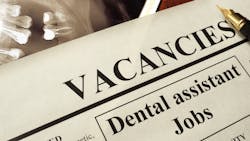As of August, the number of jobs in dental offices was high even as staff shortages also continued to be high—a seeming paradox that could indicate a “new normal” for dental staff hiring.
According to data discussed during the the State of the Dental Economy - Q3 2022 Update webinar hosted by the ADA's Health Policy Institute (HPI), latest recruitment numbers indicate that more than a third of practices polled are currently recruiting for a hygienist or assistant, and that the number of jobs in dental offices was at an all-time high, with a change of +4.8% from prepandemic levels.
But that’s jobs, not the number of people. According to information from the webinar, longer trends show a stable rate of nondentist jobs over time that suggests a “new normal” in terms of the staffing mix.
Jobs are increasing, but not necessarily the number of people, said Bradley Munson, HPI senior research analyst, adding that “staffing shortages aren’t going away any time soon; practices need to adjust.”
From 2017-2019, data shows between 5.4 and 5.8 nondentist jobs per dentist jobs, with that rate dropping to a low of 3.67 in 2020 at the start of the pandemic. The latest number indicates a rate of 5.18—lower than prepandemic levels, but consistent enough with those numbers to be considered indicative of a possible new normal.
A long-term “world of hurt” for the industry?
Inflation-adjusted wages for nondentist employees average $30.95 per hour, a change of +0.1% over prepandemic wages that panelists said was “just keeping pace” with inflation and that unless employees make benefits better or raise wages, “in a shortage market, [is] not enough,” to ease hiring difficulties, said Marko Vujicic, PhD, chief economist and HPI vice president.
Panelists had different takes when asked predictions for dental economy for the next six months, year, and beyond – with one saying the dental industry could be in a long-term “world of hurt” in terms of the hygienist shortage.
Stephen Thorne, founder of Pacific Dental Services, said he fears a shortage of hygienists for years to come for a number of reasons, including that “we need more hygiene schools.”
Other key takeaways
In September, dentists polled by HPI indicated that their practice schedules are 86% full, a holding pattern since early 2022. But while staffing shortages remain a key reason for the constraint in expanding patient volume, they’re not the only one—an increasing share of practices report not enough patients making appointments as a limiting factor. Other reasons include patient no-shows and cancellations, and COVID-19 protocols.
Through August, dental spending had recovered to 91% of prepandemic levels—a “slight bit of recovery” that is “nothing huge to write home about, but confidence is not falling,” said Vujicic.
Dental services inflation lags behind overall inflation, explainable in part by stagnant insurance reimbursement. The majority of practices, 57%, indicated that their insurance reimbursement rates have stayed roughly the same over the past.
Increases in costs along with stagnant reimbursements are likely affecting profits as well as dentists’ net income.
"Through the roof": The impact of rising costs on dentistry
“Definitely inflation is squeezing providers on the cost side, and on the revenue side, we’re not seeing an adjustment for inflation,” said Vujicic.
About the Author
Elizabeth S. Leaver
Digital content manager
Elizabeth S. Leaver was the digital content manager for Endeavor Business Media's dental group from 2021-2024. She has a degree in journalism from Northeastern University in Boston and many years of experience working in niche industries specializing in creating content, editing, content marketing, and publishing digital and magazine content. She lives in the Boston area.
